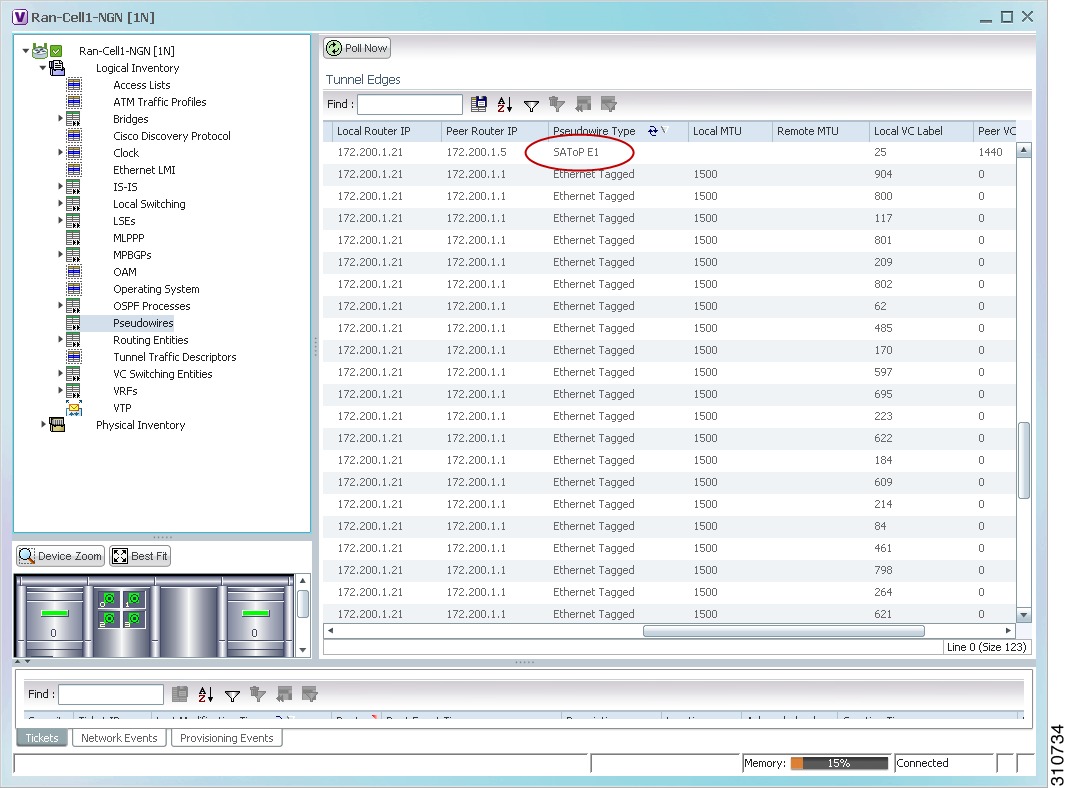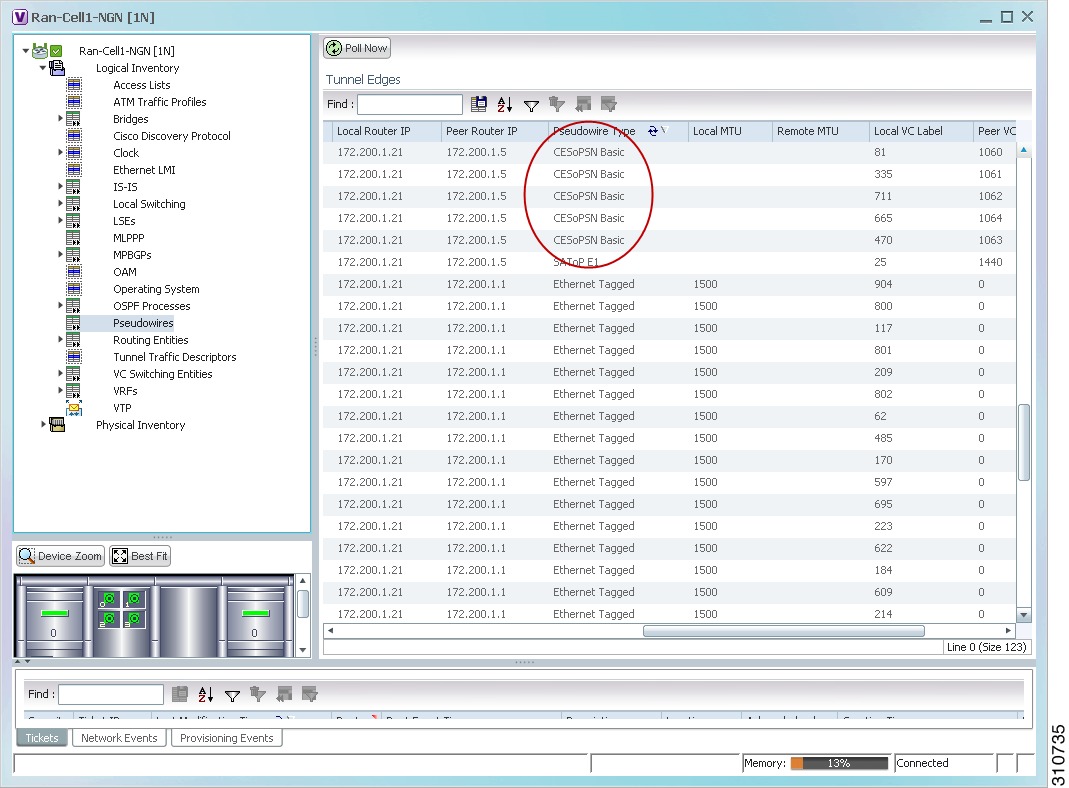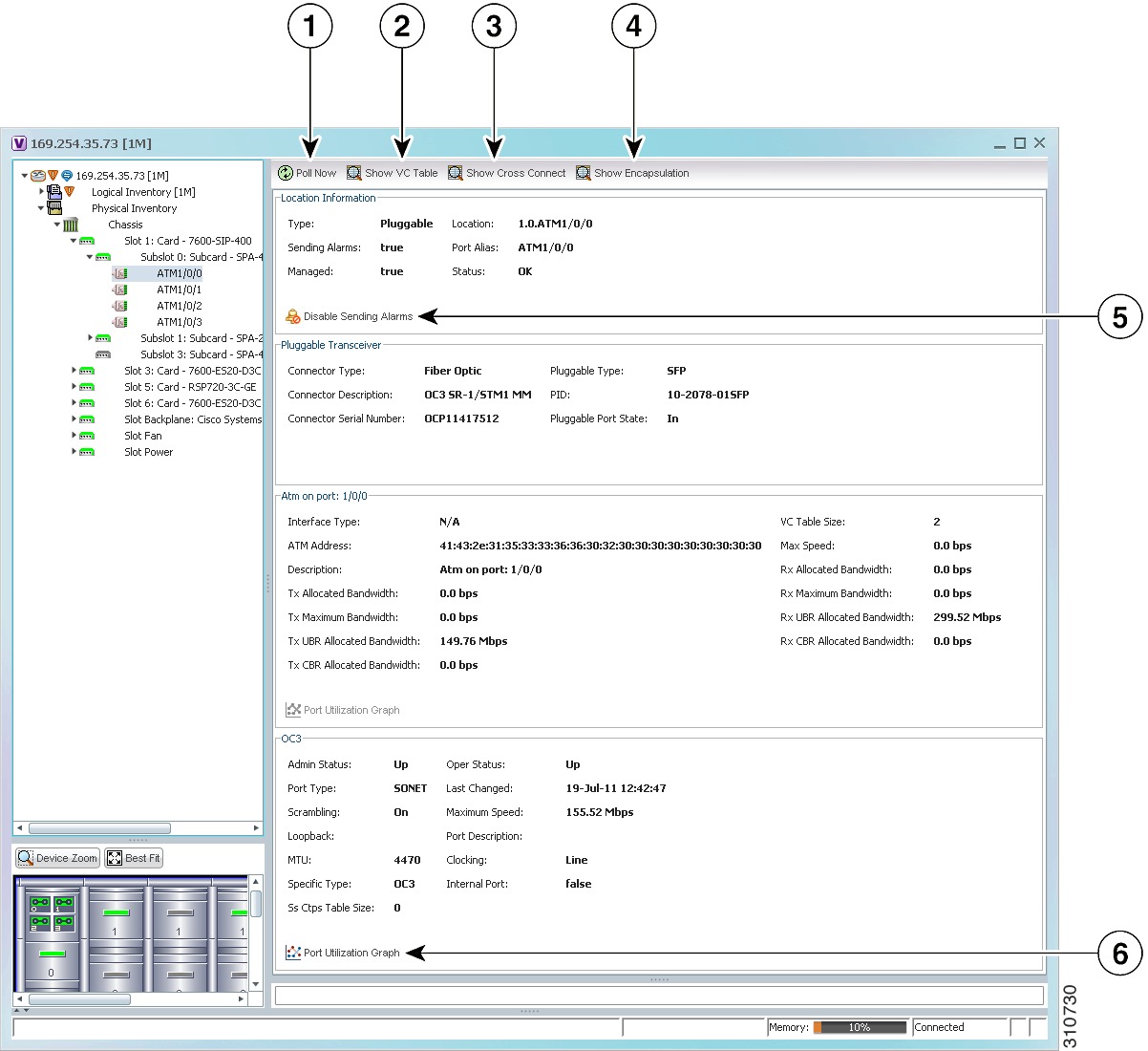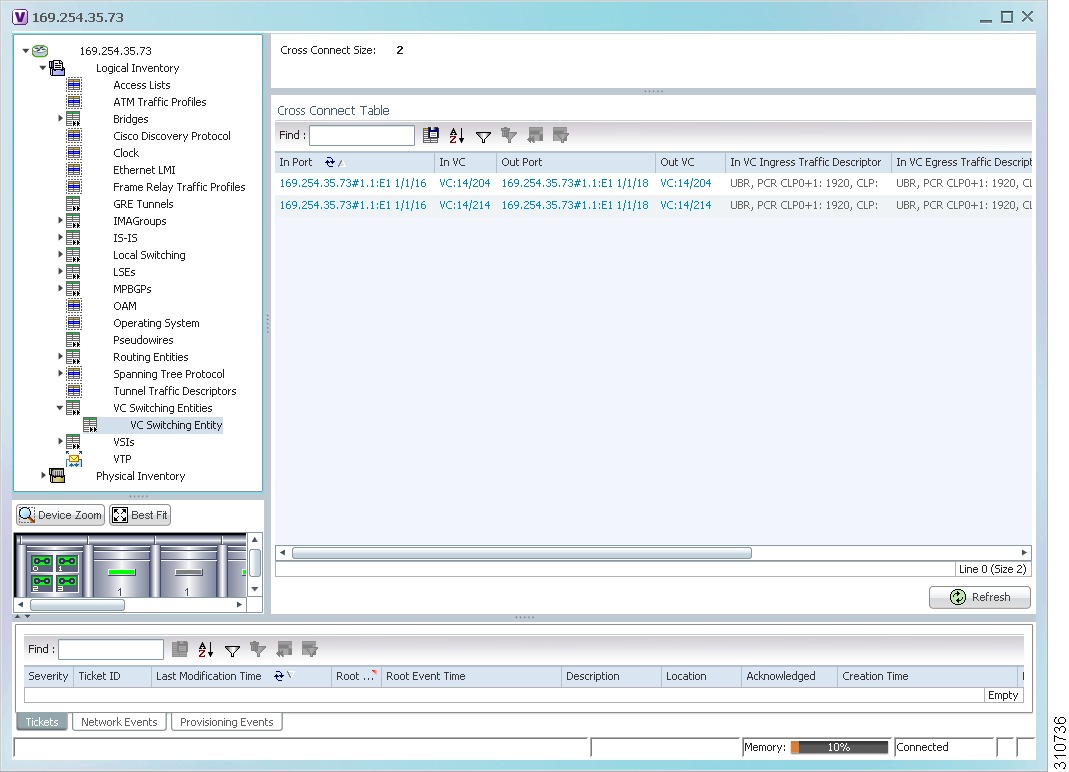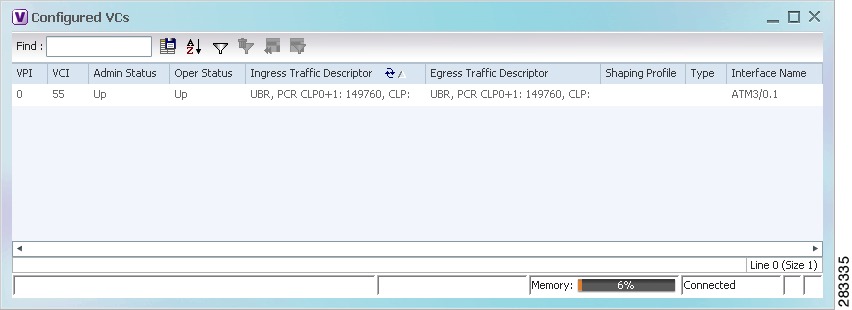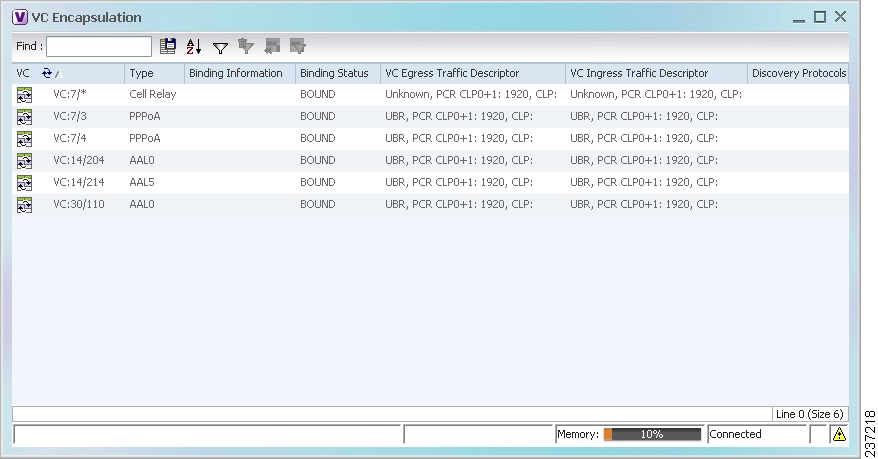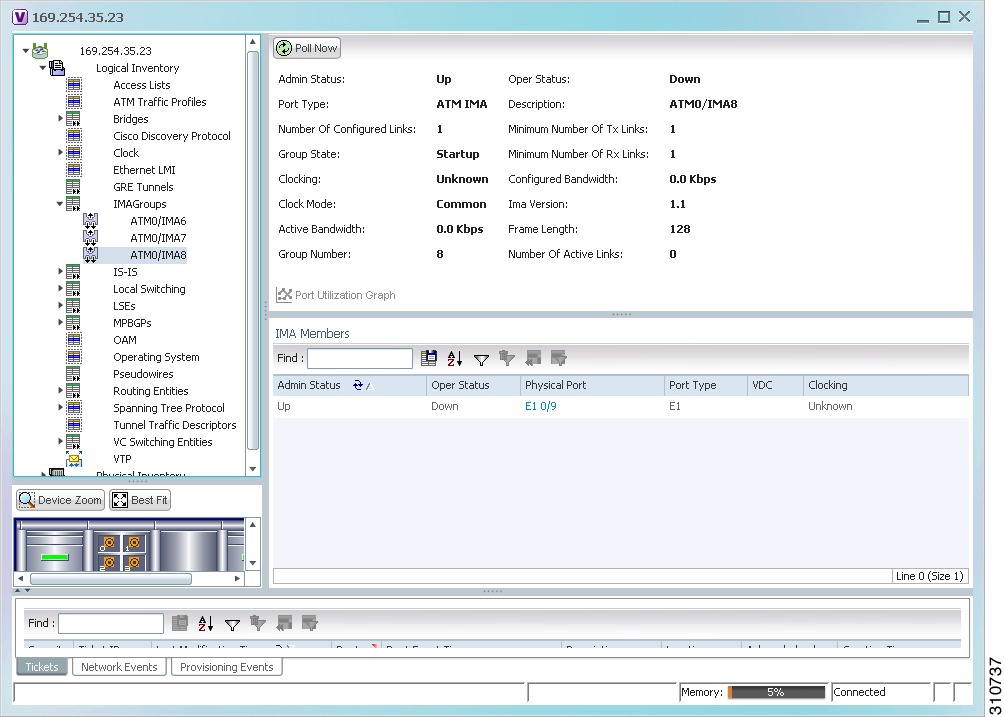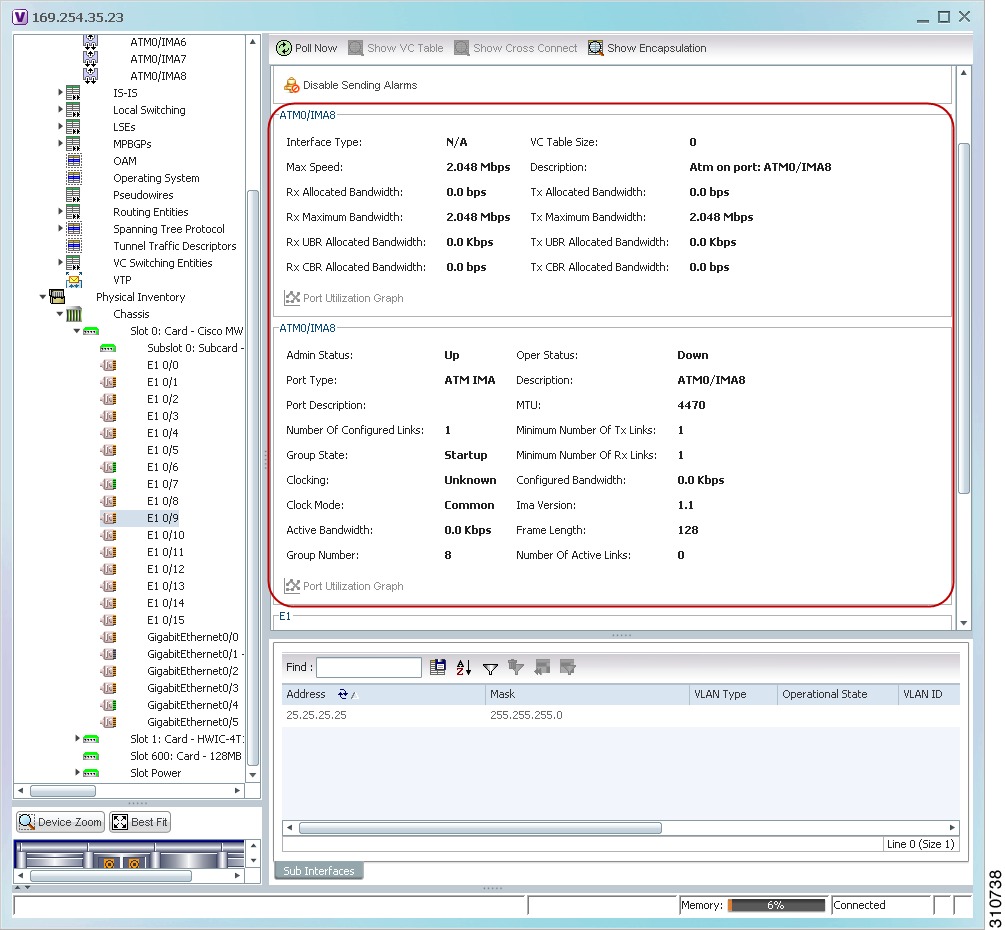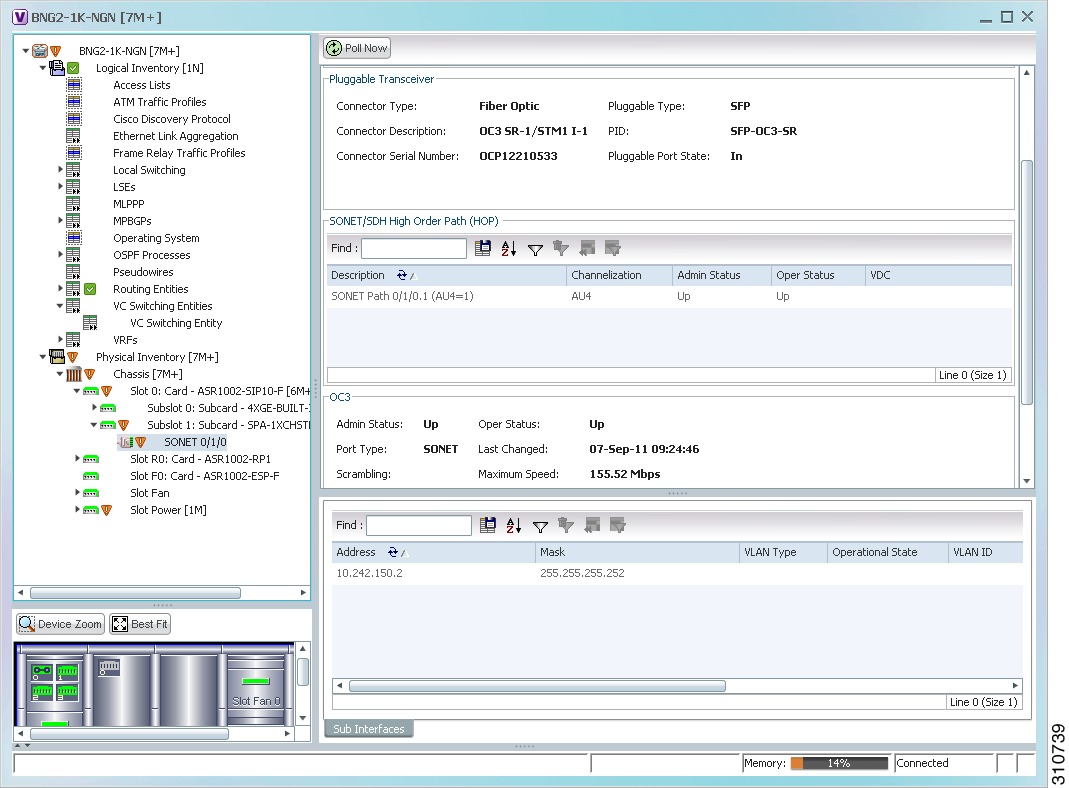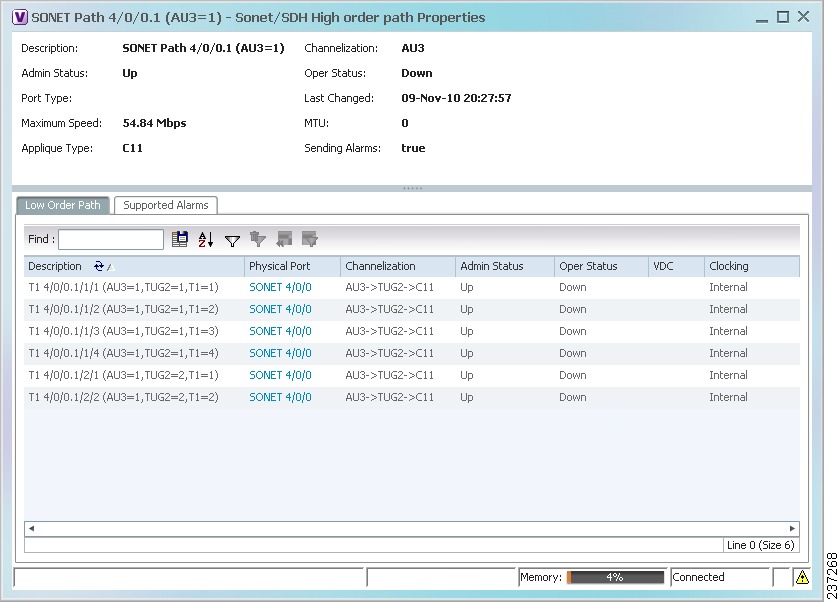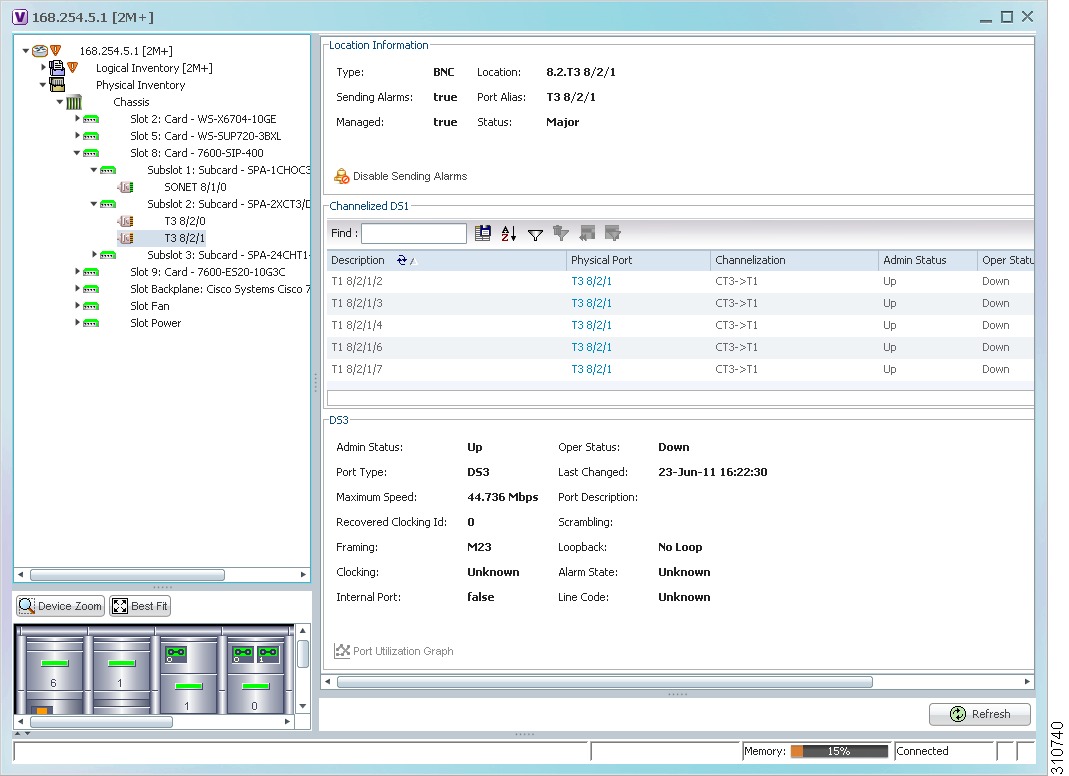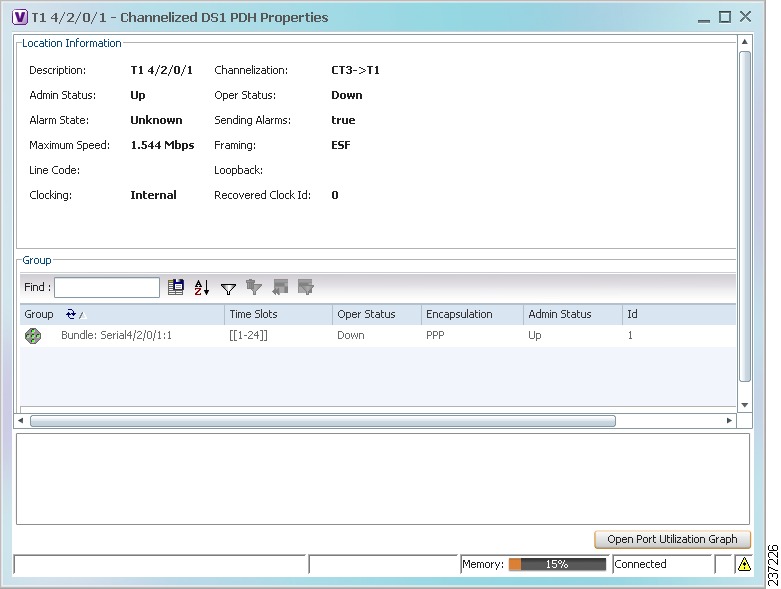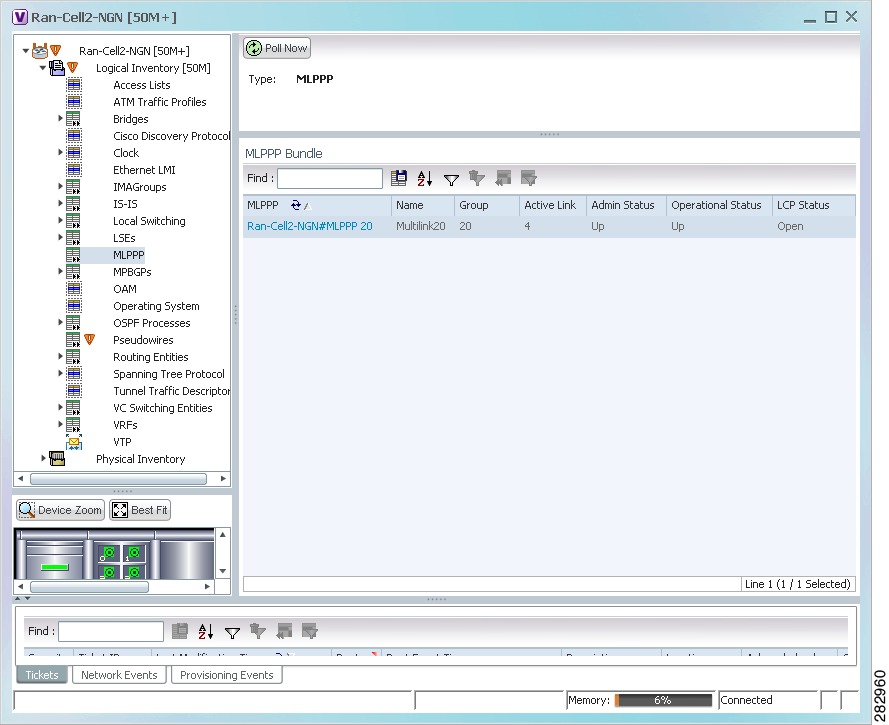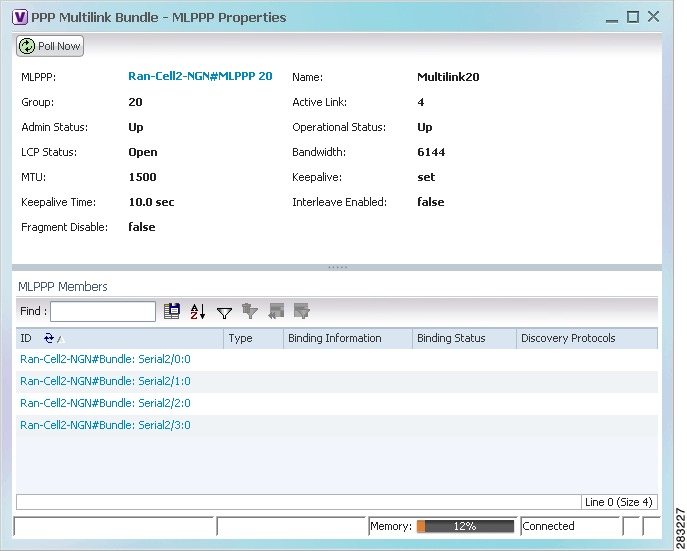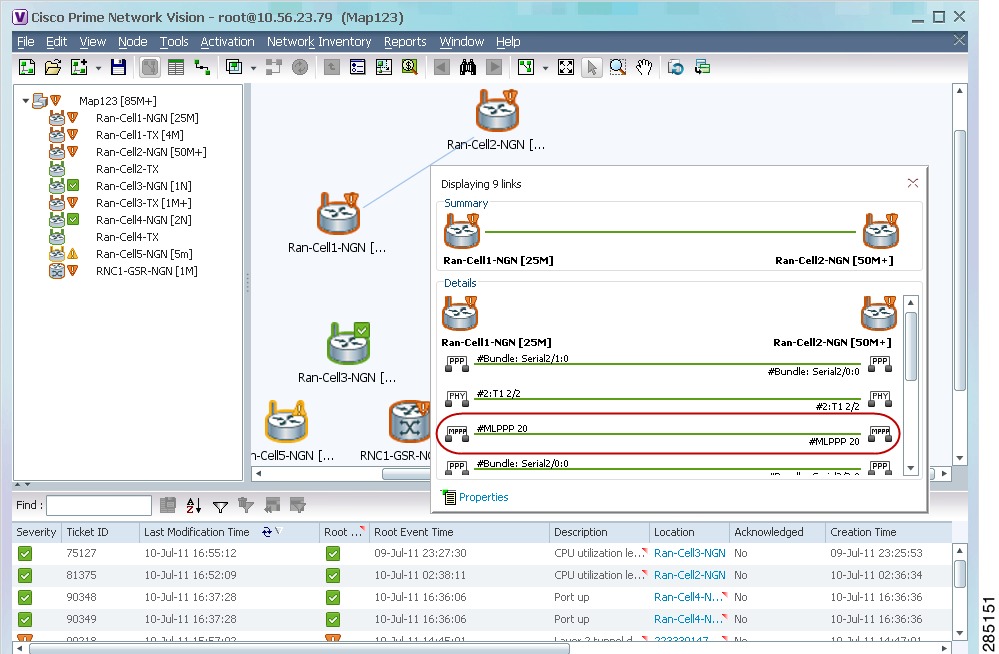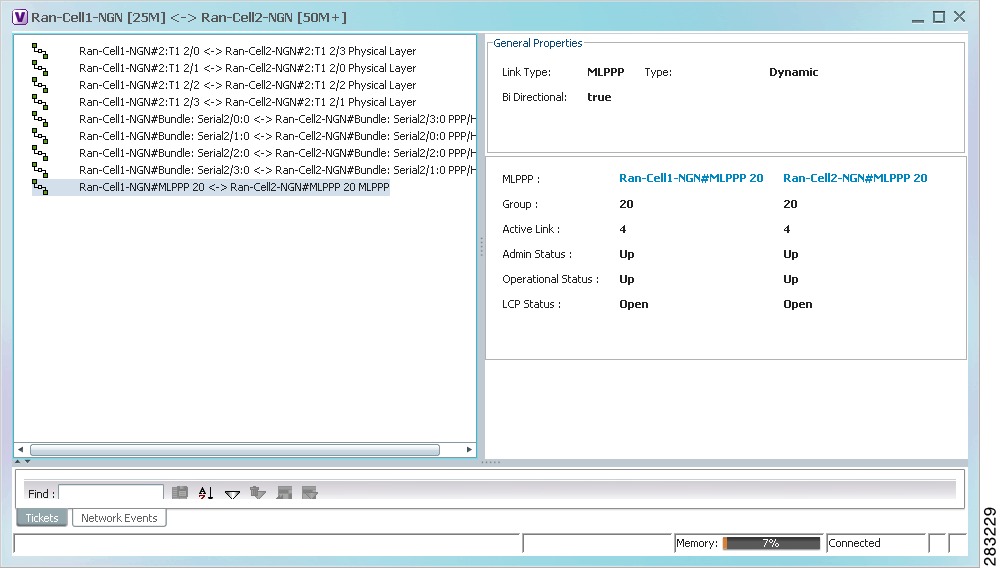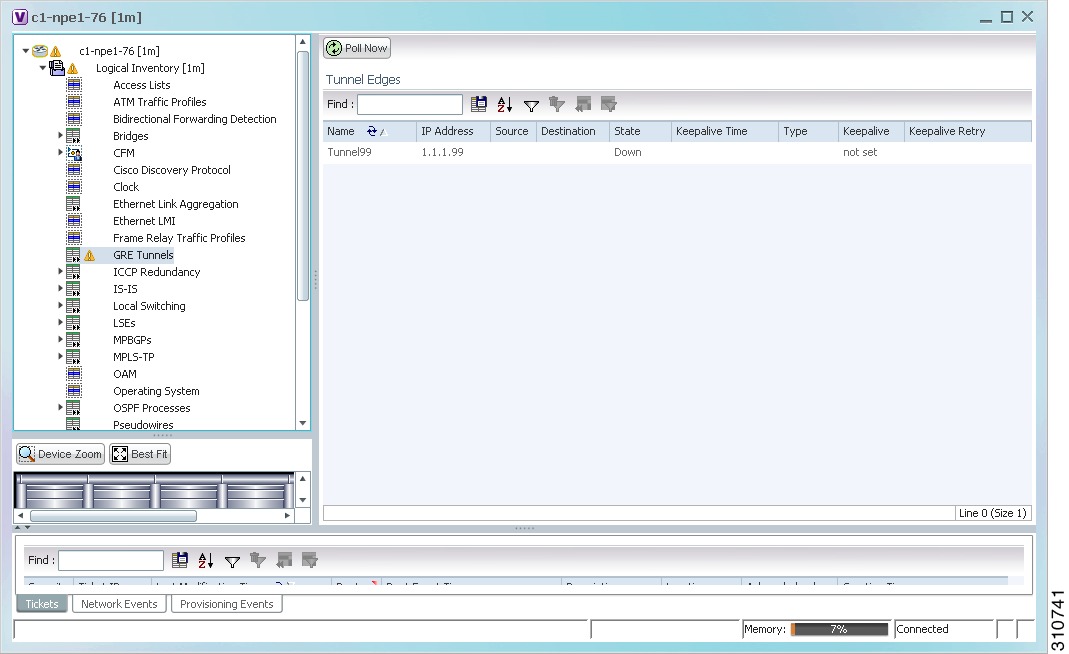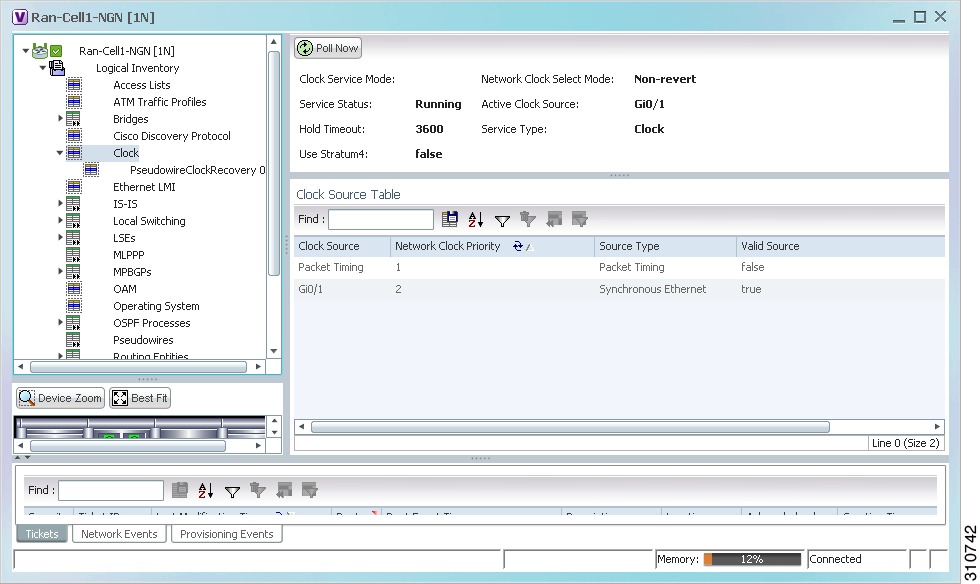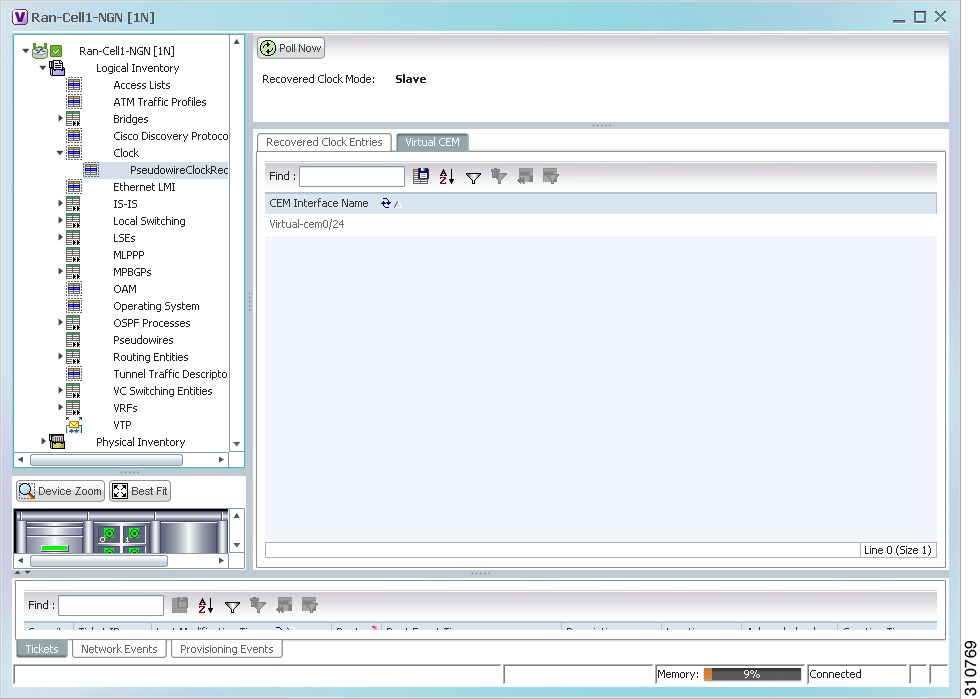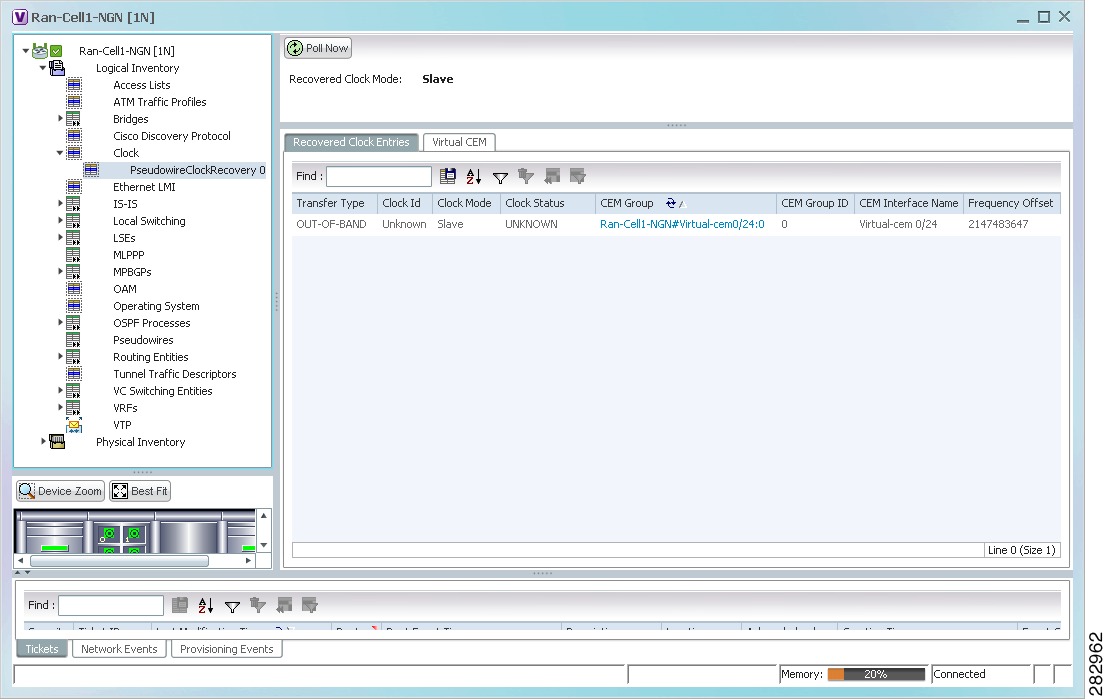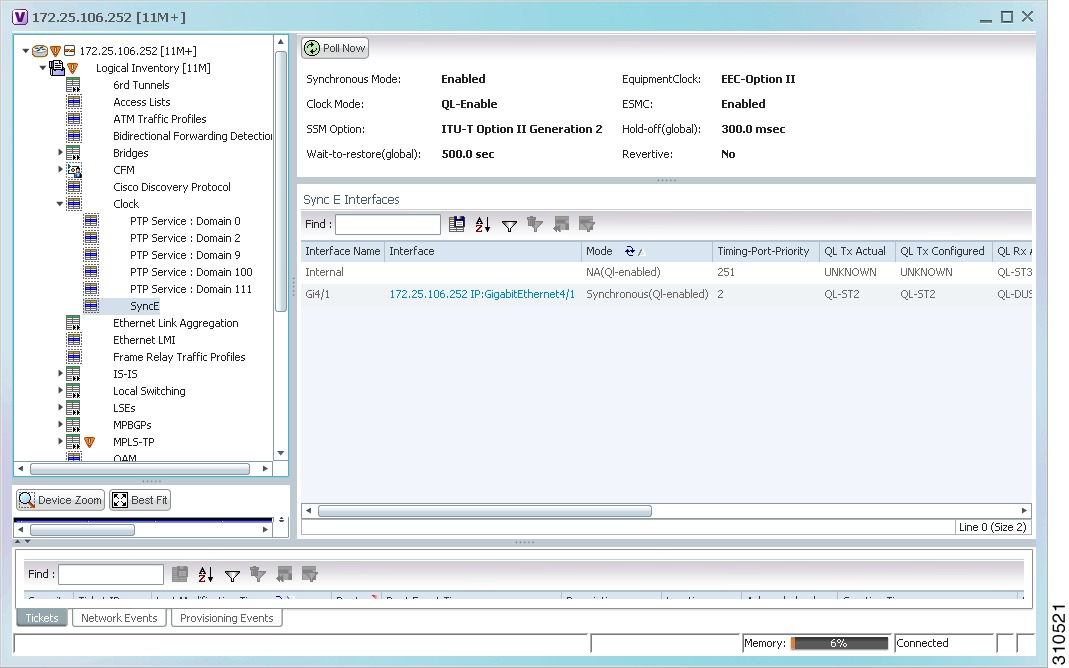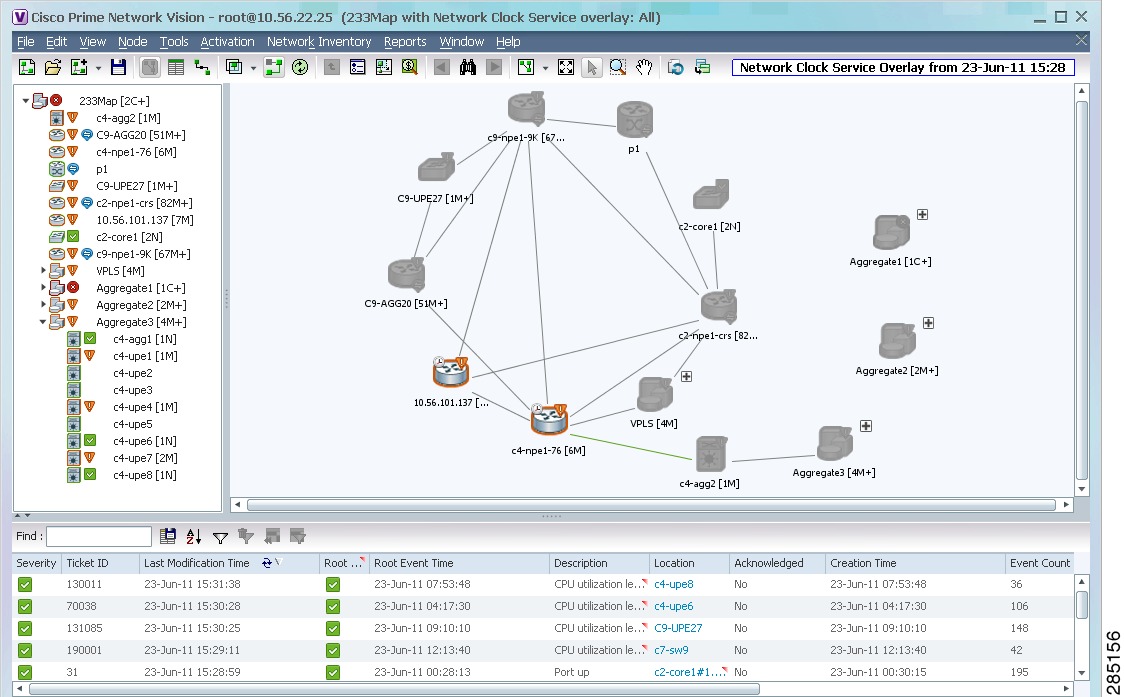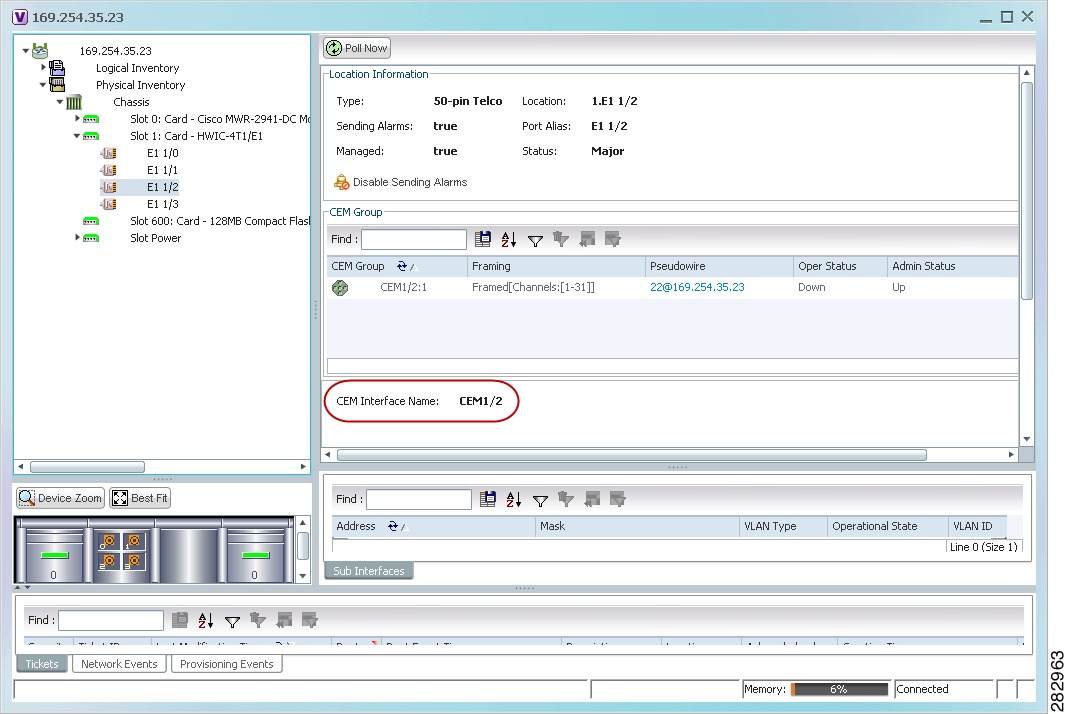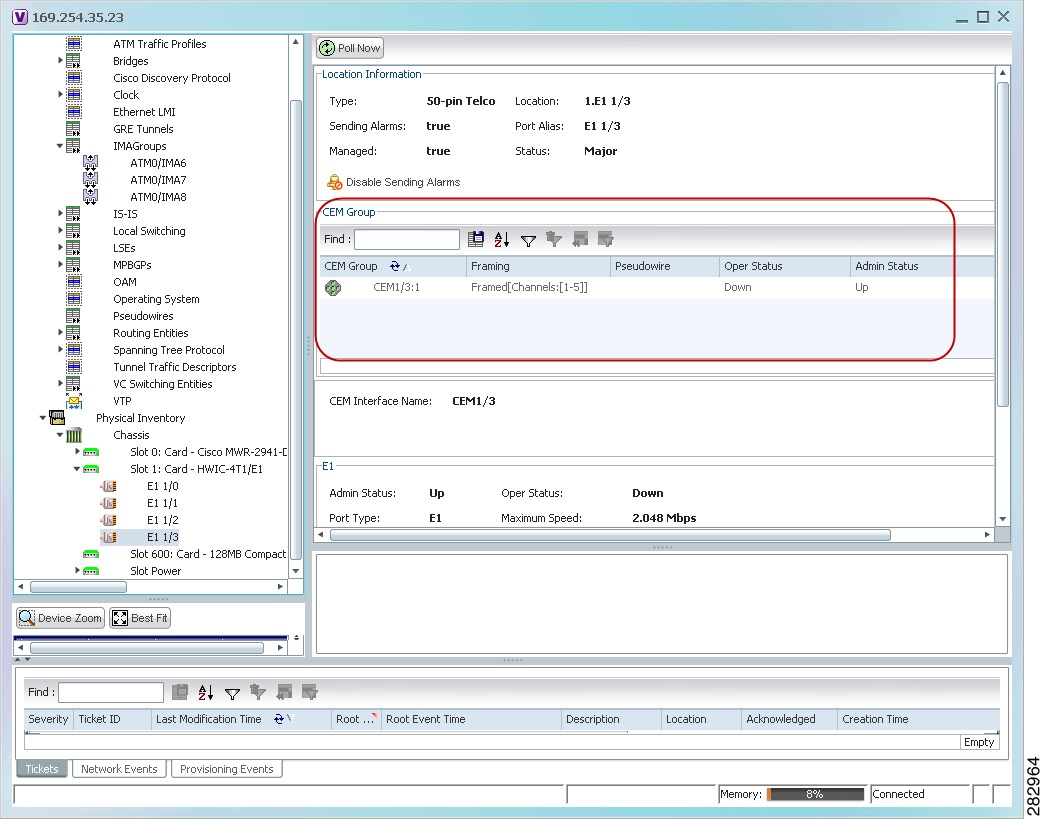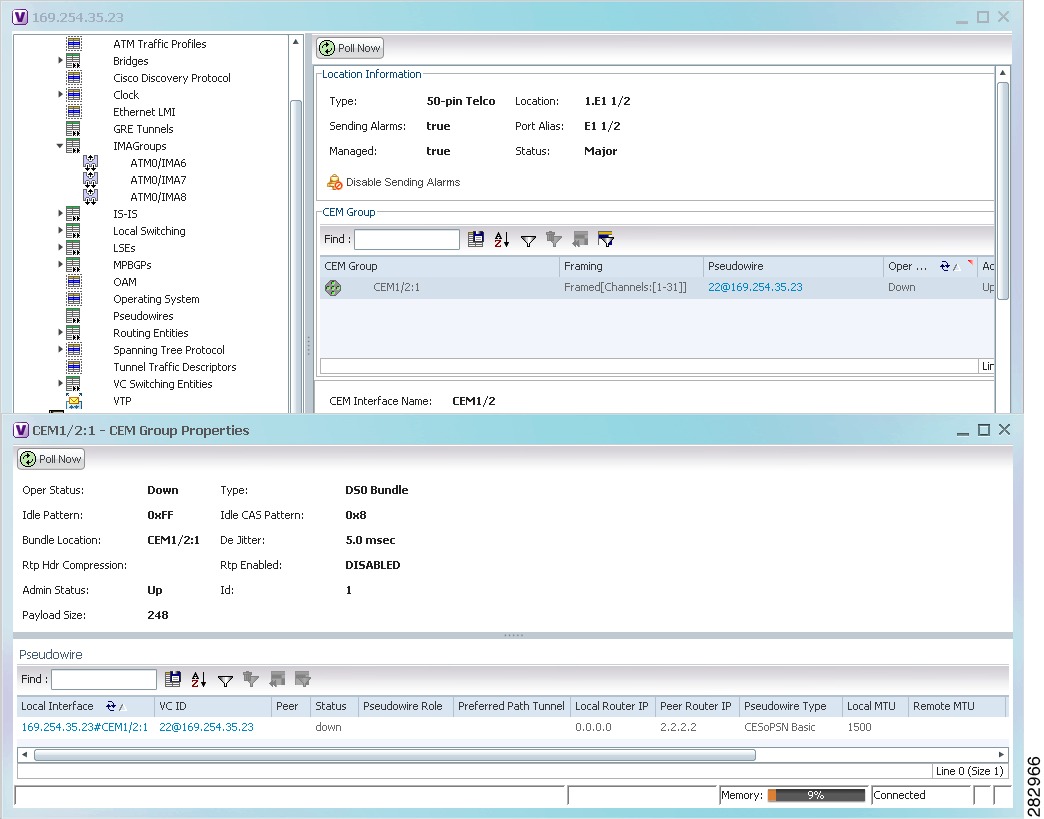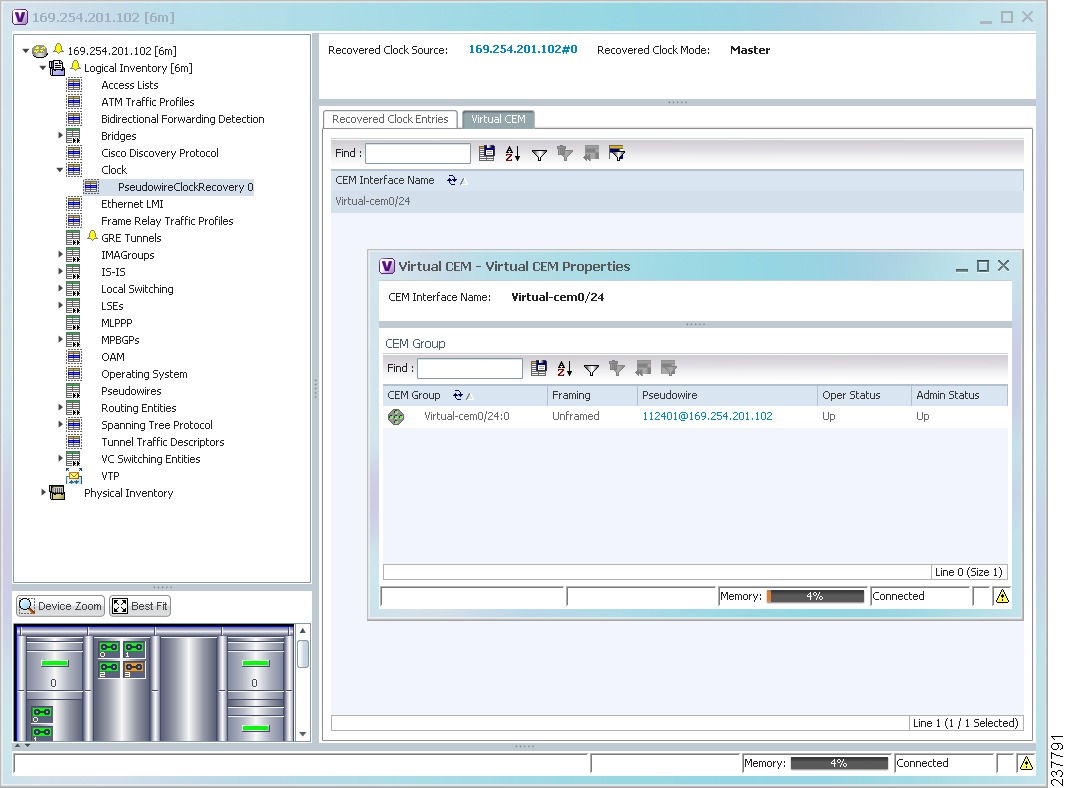

-
Cisco Prime Network User Guide, 3.10
-
Preface
-
The Prime Network GUI Clients
-
Working with the Cisco Prime Network Vision Client
-
Viewing and Managing NE Properties
-
Device Configurations and Software Images
-
Working with Prime Network Vision Maps
-
Working with Links
-
Labeling NEs Using Business Tags
-
Working with the Prime Network Events Client
-
Tracking Faults Using Prime Network Events
-
Working with Tickets in Cisco Prime Network Vision
-
Working with Reports
-
Using Cisco PathTracer to Diagnose Problems
-
Monitoring Carrier Ethernet Services
-
Monitoring Carrier Grade NAT Properties
-
Monitoring DWDM Properties
-
Viewing Ethernet Operations, Administration, and Maintenance Tool Properties
-
Monitoring Y.1731 IPSLA Configuration
-
IPv6 and IPv6 VPN over MPLS
-
Monitoring MPLS Services
-
Viewing IP and MPLS Multicast Configurations
-
Monitoring MToP Services
-
Viewing and Managing SBCs
-
Monitoring AAA Configurations
-
Monitoring IP Pools
-
Monitoring BNG Configurations
-
Monitoring Mobile Technologies
-
Monitoring Data Center Configurations
-
Icon and Button Reference
-
Glossary
-
Index
-
Table Of Contents
User Roles Required to Work with MToP
Viewing SAToP Pseudowire Type in Logical Inventory
Viewing CESoPSN Pseudowire Type in Logical Inventory
Viewing Virtual Connection Properties
Viewing ATM Virtual Connection Cross-Connects
Viewing ATM VPI and VCI Properties
Viewing Encapsulation Information
Viewing Channelization Properties
Viewing SONET/SDH Channelization Properties
Viewing T3 DS1 and DS3 Channelization Properties
Viewing MPLS Pseudowire over GRE Properties
Network Clock Service Overview
Viewing Pseudowire Clock Recovery Properties
Applying a Network Clock Service Overlay
Viewing CEM and Virtual CEM Properties
Viewing CEM Groups on Physical Interfaces
Viewing CEM Groups on Virtual CEM Interfaces
Using SONET Configure, Clear, and Show Commands
Monitoring MToP Services
The following topics describe Mobile Transport over Packet (MToP) services and the properties available in Cisco Prime Network Vision (Prime Network Vision):
•
User Roles Required to Work with MToP
•
Viewing SAToP Pseudowire Type in Logical Inventory
•
Viewing CESoPSN Pseudowire Type in Logical Inventory
•
Viewing Virtual Connection Properties
•
Viewing Channelization Properties
•
Viewing MLPPP Link Properties
•
Viewing MPLS Pseudowire over GRE Properties
•
Network Clock Service Overview
•
Viewing CEM and Virtual CEM Properties
•
Using SONET Configure, Clear, and Show Commands
User Roles Required to Work with MToP
This topic identifies the roles that are required to work with MToP in Prime Network Vision. Prime Network determines whether you are authorized to perform a task as follows:
•
For GUI-based tasks (tasks that do not affect elements), authorization is based on the default permission that is assigned to your user account.
•
For element-based tasks (tasks that do affect elements), authorization is based on the default permission that is assigned to your account. That is, whether the element is in one of your assigned scopes and whether you meet the minimum security level for that scope.
For more information on user authorization, see the Cisco Prime Network 3.10 Administrator Guide.
The following tables identify the tasks that you can perform:
•
Table 21-1 identifies the tasks that you can perform if a selected element is not in one of your assigned scopes.
•
Table 21-2 identifies the tasks that you can perform if a selected element is in one of your assigned scopes.
By default, users with the Administrator role have access to all managed elements. To change the Administrator user scope, see the topic on device scopes in the Cisco Prime Network 3.10 Administrator Guide.
Viewing SAToP Pseudowire Type in Logical Inventory
Structure-Agnostic Time Division Multiplexing (TDM) over Packet (SAToP) enables the encapsulation of TDM bit-streams (T1, E1, T3, or E3) as pseudowires over PSNs. As a structure-agnostic protocol, SAToP disregards any structure that might be imposed on the signals and TDM framing is not allowed.
To view the SAToP pseudowire type in logical inventory:
Step 1
In Prime Network Vision, right-click the device on which SAToP is configured, then choose Inventory.
Step 2
In the inventory window, choose Logical Inventory > Pseudowires.
Step 3
In the Tunnel Edges table, select the required entry and scroll horizontally until you see the Pseudowire Type column. See Figure 21-1.
Note
You can also view this information by right-clicking the entry in the table and choosing Properties.
Figure 21-1 SAToP Pseudowire Type in Logical Inventory
Step 4
To view the physical inventory for the port, click the hypertext port link.
Viewing CESoPSN Pseudowire Type in Logical Inventory
Circuit Emulation Services over PSN (CESoPSN) is a method for encapsulating structured (NxDS0) TDM signals as pseudowires over packet-switching networks, complementary to SAToP. By emulating NxDS0 circuits, CESoPSN:
•
Saves PSN bandwidth.
•
Supports DS0-level grooming and distributed cross-connect applications.
To view TDM properties for Circuit Emulation (CEM) groups in Prime Network Vision:
Step 1
In Prime Network Vision, right-click the device on which CESoPSN is configured, then choose Inventory.
Step 2
In the inventory window, choose Logical Inventory > Pseudowires.
Step 3
In the Tunnel Edges table, select the required entry and scroll horizontally until you see the Pseudowire Type column. See Figure 21-2.
Note
You can also view this information by right-clicking the entry in the table and choosing Properties.
Figure 21-2 CESoPSN Pseudowire Type in Logical Inventory
Step 4
To view the physical inventory for the port, click the hypertext port link.
Viewing Virtual Connection Properties
The following topics describe how to view properties related to virtual connections:
•
Viewing ATM Virtual Connection Cross-Connects
•
Viewing ATM VPI and VCI Properties
•
Viewing Encapsulation Information
Buttons for viewing these properties are available at the top of the physical inventory window for the selected interface, as shown in Figure 21-3.
Figure 21-3 ATM-Related Properties Available in Physical Inventory
Poll Now button
Polls the VNE for updated status.
Show VC Table button
Displays virtual circuit (VC) information for the selected port.
For more information, see Viewing ATM VPI and VCI Properties.
Show Cross Connect button
Displays cross-connect information for incoming and outgoing ports.
For more information, see Viewing ATM Virtual Connection Cross-Connects.
Show Encapsulation button
Displays encapsulation information for incoming and outgoing traffic for the selected item.
For more information, see Viewing Encapsulation Information.
Disable/Enable Sending Alarms button
Enables you to manage the alarms on a port.
For more information, see Working with Ports.
Port Utilization Graph button
Displays the selected port traffic statistics: Rx/Tx Rate and Rx/Tx Rate History.
For more information, see Generating the Port Utilization Graph.
Show DLCI Table button
(not displayed)Displays data-link connection identifier (DCLI) information for the selected port.
Viewing ATM Virtual Connection Cross-Connects
ATM networks are based on virtual connections over a high-bandwidth medium. By using cross-connects to interconnect virtual path or virtual channel links, it is possible to build an end-to-end virtual connection.
An ATM cross-connect can be mapped at either of the following levels:
•
Virtual path—Cross-connecting two virtual paths maps one Virtual Path Identifier (VPI) on one port to another VPI on the same port or a different port.
•
Virtual channel—Cross-connecting at the virtual channel level maps a Virtual Channel Identifier (VCI) of one virtual channel to another VCI on the same virtual path or a different virtual path.
Cross-connect tables translate the VPI and VCI connection identifiers in incoming ATM cells to the VPI and VCI combinations in outgoing ATM cells. For information about viewing VPI and VCI properties, see Viewing ATM VPI and VCI Properties.
To view ATM virtual connection cross-connects:
Step 1
In Prime Network Vision, right-click the required device, then choose Inventory.
Step 2
Open the VC Cross Connect table in either of the following ways:
•
In the inventory window, choose Logical Inventory > VC Switching Entities > VC Switching Entity. The Cross-Connect Table is displayed in the content pane as shown in Figure 21-4.
•
In the inventory window:
a. Choose Physical Inventory > Chassis > Slot > Subslot > Port.
b. Click the Show Cross Connect button.
The VC Cross Connections window is displayed and contains the same information as the Cross-Connect Table in logical inventory.
Step 3
Select an entry and scroll horizontally until you see the required information.
Figure 21-4 ATM Virtual Connection Cross-Connect Properties
Table 21-3 identifies the properties that are displayed for ATM VC cross-connects.
Table 21-3 ATM Virtual Connection Cross-Connect Properties
In Port
Incoming port for the cross-connect.
In VC
Incoming virtual connection for the cross-connect.
You can view additional details about the virtual connection in the following ways:
•
Click the hyperlinked entry to view the VC table.
•
Right-click the entry, then choose Properties to view information about the incoming and outgoing VCIs, VPI, service category, and traffic descriptors.
Out Port
Outgoing port for the cross-connect.
Out VC
Outgoing virtual connection for the cross-connect.
You can view additional details about the virtual connection in the following ways:
•
Click the hyperlinked entry to view the VC table.
•
Right-click the entry, then choose Properties to view information about the incoming and outgoing VCIs, VPI, service category, and traffic descriptors.
In VC Ingress Traffic Descriptor
ATM traffic parameters and service categories for the incoming traffic on the incoming VC cross-connect.
For information on VC traffic descriptors, see Table 21-4.
In VC Egress Traffic Descriptor
ATM traffic parameters and service categories for the outgoing traffic on the incoming VC cross-connect.
For information on VC traffic descriptors, see Table 21-4.
Out VC Egress Traffic Descriptor
ATM traffic parameters and service categories for the outgoing traffic on the outgoing VC cross-connect.
For information on VC traffic descriptors, see Table 21-4.
Out VC Ingress Traffic Descriptor
ATM traffic parameters and service categories for the incoming traffic on the outgoing VC cross-connect.
For information on VC traffic descriptors, see Table 21-4.
Viewing ATM VPI and VCI Properties
If you know the interface or link configured for virtual connection cross-connects, you can view ATM VPI and VCI properties from the physical inventory window or from the link properties window.
To view ATM VPI and VCI properties, open the VC Table window in either of the following ways:
•
To open the VC Table window from physical inventory:
a.
In the map view, double-click the element configured for virtual connection cross-connects.
b.
In the inventory window, choose Physical Inventory > Chassis > Slot > Subslot > Port.
c.
Click Show VC Table.
•
To view the VC Table window from the link properties window:
a.
In the map or links view, right-click the required ATM link and choose Properties.
b.
In the link properties window, click Calculate VCs.
c.
After the screen refreshes, click either Show Configured or Show Misconfigured to view the virtual connection cross-connects.
The VC Table window is displayed, as shown in Figure 21-5.
Figure 21-5 VC Table
Table 21-5 describes the information displayed in the VC Table window.
Table 21-5 VC Table Properties
VPI
Virtual Path Identifier for the selected port.
VCI
Virtual Channel Identifier for the selected port.
Admin Status
Administrative state of the connection: Up, Down, or Unknown.
Oper Status
Operational state of the connection: Up, Down, or Unknown.
Ingress Traffic Descriptor
Traffic parameters and service categories for the incoming traffic.
For information on VC traffic descriptors, see Table 21-4.
Egress Traffic Descriptor
Traffic parameters and service categories for the outgoing traffic.
For information on VC traffic descriptors, see Table 21-4.
Shaping Profile
Traffic shape profile used for the virtual connection.
Type
ATM traffic descriptor type for the virtual connection.
Interface Name
Interface name, such as ATM1/1/16.
Viewing Encapsulation Information
To view virtual connection encapsulation information:
Step 1
In Prime Network Vision, double-click the element configured for virtual connection encapsulation.
Step 2
In the inventory window, choose Physical Inventory > Chassis > Slot > Subslot > Port.
Step 3
Click the Show Encapsulation button.
The VC Encapsulation window is displayed as shown in Figure 21-6.
Figure 21-6 VC Encapsulation Properties
Table 21-6 describes the information displayed in the VC Encapsulation window.
Table 21-6 VC Encapsulation Properties
VC
Virtual connection identifier, such as VC:7/4.
Type
Type of encapsulation, such as Point-to-Point Protocol (PPP) over ATM (PPPoA) or ATM adaption layer Type 5 (AAL5).
Binding Information
Information tied to the virtual connection, such as a username.
Binding Status
Binding state: Bound or Unbound.
VC Egress Traffic Descriptor
Traffic parameters and service categories for the outgoing traffic.
For information on VC traffic descriptors, see Table 21-4.
VC Ingress Traffic Descriptor
Traffic parameters and service categories for the incoming traffic.
For information on VC traffic descriptors, see Table 21-4.
Discovery Protocols
Discovery protocol used for the VC.
Viewing IMA Group Properties
To view IMA group properties:
Step 1
In Prime Network Vision, double-click the required device.
Step 2
In the inventory window, choose Logical Inventory > IMA Groups > group. IMA group properties and the IMA Members table are displayed in the content pane as shown in Figure 21-7.
Figure 21-7 IMA Group Properties
Table 21-7 describes the information displayed for the IMA group.
Table 21-8 describes the information displayed in the IMA Members table.
Step 3
In the IMA Members table, click a hyperlinked port entry to view the port properties in physical inventory. See Figure 21-8.
The information that is displayed for the port in physical inventory depends on the type of connection, such as SONET or ATM.
Figure 21-8 ATM IMA Port in Physical Inventory
Viewing TDM Properties
TDM is a mechanism for combining two or more slower-speed data streams into a single high-speed communication channel. In this model, data from multiple sources is divided into segments that are transmitted in a defined sequence. Each incoming data stream is allocated a timeslot of a fixed length, and the data from each stream is transmitted in turn. For example, data from data stream 1 is transmitted during timeslot 1, data from data stream 2 is transmitted during timeslot 2, and so on. After each incoming stream has transmitted data, the cycle begins again with data stream 1. The transmission order is maintained so that the input streams can be reassembled at the destination.
MToP encapsulates TDM streams for delivery over packet-switching networks (PSNs) using the following methods:
•
SAToP—A method for encapsulating TDM bit-streams (T1, E1, T3, or E3) as pseudowires over PSNs.
•
CESoPSN—A method for encapsulating structured (NxDS0) TDM signals as pseudowires over PSNs.
For T1 or E1 entries, the TDM properties presented in Table 21-9 are displayed in physical inventory in addition to the existing T1 or E1 properties.
Viewing Channelization Properties
Prime Network Vision supports the channelization of SONET/SDH and T3 lines. When a line is channelized, it is logically divided into smaller bandwidth channels called paths. These paths (referred to as high order paths or HOPs) can, in turn, contain low order paths, or LOPs. The sum of the bandwidth on all paths cannot exceed the line bandwidth.
The following topics describe how to view channelization properties for SONET/SDH and T3 lines:
•
Viewing SONET/SDH Channelization Properties
•
Viewing T3 DS1 and DS3 Channelization Properties
Viewing SONET/SDH Channelization Properties
SONET and SDH use the same concepts for channelization, but the terminology differs. Table 21-10 describes the equivalent terms for SONET and SDH channelization. The information displayed in Prime Network Vision reflects whether SONET or SDH is configured on the interface.
To view SONET/SDH channelization properties:
Step 1
In Prime Network Vision, right-click the required device, then choose Inventory.
Step 2
Choose Physical Inventory > Chassis > slot > subslot > SONET/SDH-interface. The properties for SONET/SDH and OC-3 are displayed in the content pane. See Figure 21-9.
Figure 21-9 SONET/SDH Interface in Physical Inventory
Table 21-11 describes the information that is displayed for SONET/SDH and OC3 in the content pane.
Step 3
To view additional information about a channelized path, double-click the required entry in the Description column. The SONET/SDH High Order Path Properties window is displayed as shown in Figure 21-10.
Figure 21-10 SONET/SDH High Order Path Properties Window
Table 21-12 describes the information displayed in SONET/SDH High Order Path Properties window.
Viewing T3 DS1 and DS3 Channelization Properties
To view T3 DS1 and DS3 channelization properties:
Step 1
In Prime Network Vision, right-click the required device, then choose Inventory.
Step 2
Choose Physical Inventory > Chassis > slot > subslot > T3-interface.
Figure 21-11 shows DS1 channelization properties for T3 in physical inventory.
Figure 21-11 T3 DS1 Channelization Properties in Physical Inventory
Table 21-13 describes the information that is displayed for Channelized DS1 and DS3 in the content pane.
Step 3
To view additional information about a DS1channelized path, double-click the required entry in the Channelized DS1 table. Figure 21-12 shows the information that is displayed in the Channelized DS1 PDH Properties window.
Figure 21-12 Channelized DS1 PDH Properties Window
Table 21-14 describes the information that is displayed in the Channelized DS1 PDH Properties window.
Viewing MLPPP Properties
Multilink PPP (MLPPP) is a protocol that connects multiple links between two systems as needed to provide bandwidth when needed. MLPPP packets are fragmented, and the fragments are sent at the same time over multiple point-to-point links to the same remote address. MLPPP provides bandwidth on demand and reduces transmission latency across WAN links.
To view MLPPP properties:
Step 1
In Prime Network Vision, right-click the required device, then choose Inventory.
Step 2
In the inventory window, choose Logical Inventory > MLPPP. See Figure 21-13.
Figure 21-13 MLPPP Properties in Logical Inventory
Table 21-15 describes the information that is displayed for MLPPP.
Step 3
To view properties for individual MLPPP bundles, double-click the hyperlinked entry in the MLPPP Bundle table.
The MLPPP Properties window is displayed as shown in Figure 21-14.
Figure 21-14 MLPPP Bundle Properties Window
Table 21-16 describes the information that is displayed in the MLPPP Properties window.
Step 4
To view the interface properties in physical inventory, double-click the required entry in the ID column.
Viewing MLPPP Link Properties
An MLPPP link is a link that connects two MLPPP devices.
To view MLPPP link properties:
Step 1
In the Prime Network Vision map view, select a link connected to two MLPPP devices and open the link quick view window as shown in Figure 21-15.
Figure 21-15 MLPPP Link in Link Quick View
Step 2
In the link quick view window, click Properties.
Step 3
In the link properties window, select the MLPPP link. The link properties are displayed as shown in Figure 21-16.
Figure 21-16 MLPPP Link Properties
Table 21-17 describes the information that is displayed for the MLPPP link.
Viewing MPLS Pseudowire over GRE Properties
Generic routing encapsulation (GRE) is a tunneling protocol, originated by Cisco Systems and standardized in RFC 2784. GRE encapsulates a variety of network layer packets inside IP tunneling packets, creating a virtual point-to-point link to devices at remote points over an IP network. GRE encapsulates the entire original packet with a standard IP header and GRE header before the IPsec process. GRE can carry multicast and broadcast traffic, making it possible to configure a routing protocol for virtual GRE tunnels.
In RAN backhaul networks, GRE is used to transport cell site traffic across IP networks (nonMPLS). In addition, GRE tunnels can be used to transport TDM traffic (TDMoMPLSoGRE) as part of the connectivity among cell site-facing Cisco 7600 routers and base station controller (BSC) site-facing Cisco 7600 routers, or between a Cisco Mobile Wireless Router (MWR) device and a BSC site-facing Cisco 7600 router.
Using GRE tunnels to transport Any Traffic over MPLS (AToM) enables mobile service providers to deploy AToM pseudowires in a network where MPLS availability is discontinuous; for example, in networks where the pseudowire endpoints are located in MPLS edge routers with a plain IP core network, or where two separate MPLS networks are connected by a transit network with plain IP forwarding.
To view the properties for MPLS pseudowire over GRE:
Step 1
In Prime Network Vision, right-click the required device, then choose Inventory.
Step 2
In the inventory window, choose Logical Inventory > Pseudowires. The Tunnel Edges table is displayed in the content pane as shown in Figure 21-17.
Step 3
Select the required entry and scroll horizontally until you see the required information.
Figure 21-17 MPLS Pseudowire Tunnels over GRE Properties
Table 21-18 describes the information included in the Tunnel Edges table specifically for MPLS pseudowire tunnels over GRE.
Step 4
To view GRE Tunnel properties, choose Logical Inventory > GRE Tunnels.
Figure 21-18 shows the Tunnel Edges table that is displayed for GRE tunnels.
Figure 21-18 GRE Tunnel Properties in Logical Inventory
Table 21-19 describes the information that is displayed for GRE tunnels in logical inventory.
Network Clock Service Overview
Network clock service refers to the means by which a clock signal is generated or derived and distributed through a network and its individual nodes for the purpose of ensuring synchronized network operation. Network clocking is particularly important for mobile service providers to ensure proper transport of cellular traffic from cell sites to Base Station Control (BSC) sites.
Note
In Prime Network Vision, clock service refers to network clock service.
The following topics describe how to use Prime Network Vision to monitor clock service:
•
Viewing Pseudowire Clock Recovery Properties
•
Applying a Network Clock Service Overlay
Monitoring Clock Service
To monitor clock service:
Step 1
In Prime Network Vision, right-click the required device, then choose Inventory.
Step 2
In the inventory window, choose Logical Inventory > Clock. Clock service information is displayed in the content pane as shown in Figure 21-19.
Figure 21-19 Clock Service Properties
Table 21-20 describes the information displayed for clocking service.
Monitoring PTP Service
In networks that employ TDM, periodic synchronization of device clocks is required to ensure that the receiving device knows which channel is which for accurate reassembly of the data stream. The Precision Time Protocol (PTP) standard:
•
Specifies a clock synchronization protocol that enables this synchronization.
•
Applies to distributed systems that consist of one or more nodes communicating over a network.
Defined by IEEE 1588-2008, PTP Version 2 (PTPv2) allows device synchronization at the nanosecond level.
PTP uses the concept of master and slave devices to achieve precise clock synchronization. Using PTP, the master device periodically starts a message exchange with the slave devices. After noting the times at which the messages are sent and received, each slave device calculates the difference between its system time and the system time of the master device. The slave device then adjusts its clock so that it is synchronized with the master device. When the master device initiates the next message exchange, the slave device again calculates the difference and adjusts its clock. This repetitive synchronization ensures that device clocks are coordinated and that data stream reassembly is accurate.
To monitor PTP service:
Step 1
In Prime Network Vision, right-click the required device, then choose Inventory.
Step 2
In the inventory window, choose Logical Inventory > Clock > PTP Service. The PTP service properties are displayed in the content pane as shown in Figure 21-20.
Figure 21-20 PTP Service Properties
Table 21-21 describes the properties that are displayed for PTP service.
Viewing Pseudowire Clock Recovery Properties
To view pseudowire clock recovery properties:
Step 1
Choose Logical Inventory > Clock > Pseudowire Clock Recovery. Prime Network Vision displays the Virtual CEM information by default. See Figure 21-21.
Figure 21-21 Pseudowire Clock Recovery - Virtual CEM Tab
Step 2
To view more information about a virtual CEM, right-click the virtual CEM, then choose Properties. The Virtual CEM Properties window is displayed.
The information that is displayed in the Virtual CEM Properties window depends on whether or not the virtual CEM belongs to a group:
•
If a CEM group is not configured on the virtual CEM, the Virtual CEM Properties window contains only the CEM interface name.
•
If a CEM group is configured on the virtual CEM, the Virtual CEM Properties window contains the information described in Table 21-22.
Step 3
To view additional CEM group properties, double-click the required CEM group.
Table 21-23 describes the information displayed in the CEM Group Properties window.
Step 4
To view recovered clock entries, click the Recovered Clock Entries tab. See Figure 21-22.
If no recovered clock entries exist, this tab is not displayed.
Figure 21-22 Pseudowire Clock Recovery - Recovered Clock Entries Tab
Table 21-24 describes the information displayed for pseudowire clock recovery.
Viewing SyncE Properties
With Ethernet equipment gradually replacing SONET and SDH equipment in service-provider networks, frequency synchronization is required to provide high-quality clock synchronization over Ethernet ports. Synchronous Ethernet (SyncE), a recently adopted standard, provides the required synchronization at the physical level.
In SyncE, Ethernet links are synchronized by timing their bit clocks from high-quality, stratum-1-traceable clock signals in the same manner as SONET/SDH. Operations messages maintain SyncE links, and ensure a node always derives timing from the most reliable source.
To view SyncE properties, choose Logical Inventory > Clock > SyncE. (See Figure 21-23.)
Figure 21-23 SyncE Properties in Logical Inventory
Table 21-25 describes the information that is displayed for SyncE.
Table 21-25 SyncE Properties
Synchronous Mode
Status of the automatic synchronization selection process: Enabled or Disable.
Equipment Clock
Ethernet Equipment Clock (EEC) options: EEC-Option I or EEC-Option II.
Clock Mode
Whether the clock is enabled or disabled for the Quality Level (QL) function: QL-Enabled or QL-Disabled.
ESMC
Ethernet Synchronization Message Channel (ESMC) status: Enabled or Disabled.
SSM Option
Synchronization Status Message (SSM) option being used:
•
ITU-T Option I
•
ITU-T Option II Generation 1
•
ITU-T Option II Generation 2
Hold-off (global)
Length of time (in milliseconds) to wait before issuing a protection response to a failure event.
Wait-to-restore (global)
Length of time (in seconds) to wait after a failure is fixed before the span returns to its original state.
Revertive
Whether the network clock is to use revertive mode: Yes or No.
Interface Name
Name of the Gigabit or 10 Gigabit interface associated with SyncE.
If SyncE is not associated with a Gigabit or 10 Gigabit interface, this field contains Internal.
Interface
Hyperlinked entry to the interface routing information in the Routing Entity Controller window. For more information, see Viewing Routing Entities.
This field does not apply for Internal interfaces.
Mode
Whether the interface is enabled or disabled for the QL function: QL-Enabled or QL-Disabled.
Timing Port Priority
Value used for selecting a SyncE interface for clocking if more than one interface is configured. Values are from 1 to 250, with 1 being the highest priority.
QL Tx Actual
Actual type of outgoing quality level information, depending on the globally configured SSM option:
•
ITU-T Option I—Available values are QL-PRC, QL-SSU-A, QL-SSU-B, QL-SEC, and QL-DNU.
•
ITU-T Option II Generation 1—Available values are QL-PRS, QL-STU, QL-ST2, QL-SMC, QL-ST4, and QL-DUS.
•
ITU-T Option II Generation 2—Available values are QL-PRS, QL-STU, QL-ST2, QL-TNC, QL-ST3, QL-SMC, QL-ST4, and QL-DUS.
QL Tx Configured
Configured type of outgoing quality level information, depending on the globally configured SSM option.
See QL Tx Actual for the available values.
QL Rx Actual
Actual type of incoming quality level information, depending on the globally configured SSM option.
See QL Tx Actual for the available values.
QL Rx Configured
Configured type of incoming quality level information, depending on the globally configured SSM option.
See QL Tx Actual for the available values.
Hold-Off Timer (msecs)
Length of time (in milliseconds) to wait after a clock source goes down before removing the source.
Wait-to-Restore (secs)
Length of time (in seconds) to wait after a failure is fixed before the interface returns to its original state.
ESMC Tx
Whether ESMC is enabled for outgoing QL information on the interface: Enabled, Disabled, or NA (Not Available).
ESMC Rx
Whether ESMC is enabled for incoming QL information on the interface: Enabled, Disabled, or NA (Not Available).
SSM Tx
Whether SSM is enabled for outgoing QL information on the interface: Enabled, Disabled, or NA (Not Available).
SSM Rx
Whether SSM is enabled for incoming QL information on the interface: Enabled, Disabled, or NA (Not Available).
Applying a Network Clock Service Overlay
A service overlay allows you to isolate the parts of a network that are being used by a particular service. This information can then be used for troubleshooting. For example, the overlay can highlight configuration or design problems when bottlenecks occur and all the site interlinks use the same link.
To apply a network clock overlay:
Step 1
In Prime Network Vision, display the network map on which you want to apply an overlay.
Step 2
From the main toolbar, click Choose Overlay Type and choose Network Clock.
The Select Network Clock Service Overlay dialog box is displayed.
Step 3
Do one of the following:
•
Choose a search category, enter a search string, then click Go to narrow the search results to a range of network clock services or a specific network clock service. Search categories include:
–
Description
–
Name
The search condition is "contains." Search strings are case-insensitive. For example, if you choose the Name category and enter "net," Prime Network Vision displays network clock services that have "net" in their names whether net appears at the beginning of the name, the middle, or at the end: for example, Ethernet.
•
Choose Show All to display all network clock services.
Step 4
Select the network clock service overlay that you want to apply to the map.
The elements and links used by the selected network clock are highlighted in the map, and the overlay name is displayed in the title of the window. (See Figure 21-24.)
Figure 21-24 Network Clock Service Overlay Example
In addition, the elements configured for clocking service display a clock service icon as in the following example:
Note
An overlay is a snapshot taken at a specific point in time and does not reflect changes that occur in the service. As a result, the information in an overlay can become stale. To update the overlay, click Refresh Overlay in the main toolbar.
Viewing CEM and Virtual CEM Properties
The following topics describe how to view CEM and virtual CEM properties and interfaces:
Viewing CEM Interfaces
To view CEM interfaces:
Step 1
In Prime Network Vision, double-click the required device.
Step 2
In the inventory window, choose Physical Inventory > Chassis > slot > subslot > interface. The CEM interface name is displayed in the content pane as shown in Figure 21-25.
Figure 21-25 CEM Interface
Viewing Virtual CEMs
To view virtual CEMs, choose Logical Inventory > Clock > Pseudowire Clock Recovery.
The virtual CEM interfaces are listed in the Virtual CEM tab.
Viewing CEM Groups
CEM groups can be configured on physical or virtual CEM interfaces. The underlying interface determines where you view CEM group properties in Prime Network Vision:
•
Viewing CEM Groups on Physical Interfaces
•
Viewing CEM Groups on Virtual CEM Interfaces
Viewing CEM Groups on Physical Interfaces
When you configure a CEM group on a physical interface, the CEM group properties are displayed in physical inventory for that interface.
To view CEM groups configured on physical interfaces:
Step 1
In Prime Network Vision, double-click the required device.
Step 2
In the inventory window, choose Physical Inventory > Chassis > slot > subslot > interface.
The CEM group information is displayed in the content pane with other interface properties (Figure 21-26).
Figure 21-26 CEM Group Information
See Table 21-22 for a description of the properties displayed for CEM groups in the content pane.
Step 3
To view additional information, double-click the required group.
The CEM Group Properties window is displayed as shown in Figure 21-27.
Figure 21-27 CEM Group Properties Window
See Table 19-30 for the properties displayed in the Pseudowire table in the CEM Group Properties window.
Viewing CEM Groups on Virtual CEM Interfaces
When you configure a CEM group on a virtual CEM, the CEM group information is displayed below the virtual CEM in logical inventory.
To view CEM groups on virtual CEM interfaces:
Step 1
In Prime Network Vision, right-click the required device, then choose Inventory.
Step 2
In the inventory window, choose Logical Inventory > Clock > Pseudowire Clock Recovery.
Step 3
In the Virtual CEM tab, right-click the CEM interface name and choose Properties. The CEM group properties are displayed in a separate window (Figure 21-28). If a pseudowire is configured on the CEM group for out-of-band clocking, the pseudowire VCID is also shown.
Figure 21-28 CEM Group Properties
Step 4
To view additional CEM group properties, double-click the required CEM group.
Table 21-23 describes the information displayed in the CEM Group Properties window.
Using SONET Configure, Clear, and Show Commands
The following commands can be launched from the inventory by right-clicking a SONET port and selecting Commands > SONET. Before executing any commands, you can preview them and view the results. If desired, you can also schedule the commands. To find out if a device supports these commands, see the Cisco Prime Network 3.10 Supported Cisco VNEs.
Note
You might be prompted to enter your device access credentials while executing a command. Once you have entered them, these credentials will be used for every subsequent execution of a command in the same GUI client session. If you want to change the credentials, click Edit Credentials. Edit Credentials button will not be available for SNMP commands or if the command is scheduled for a later time.

 Feedback
Feedback
